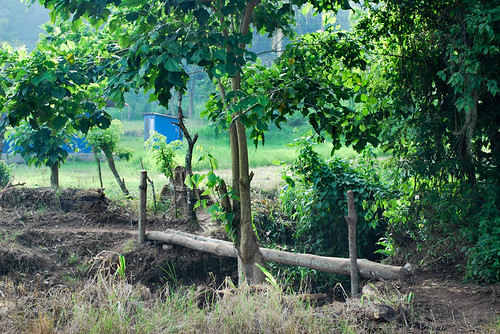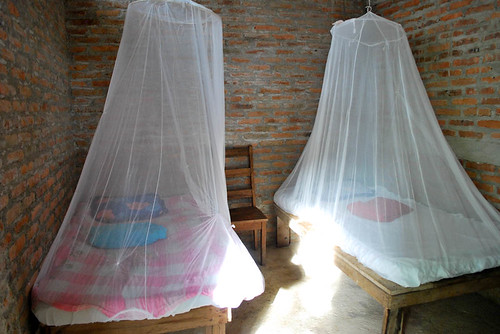We visited the community La Pita. This community was part of a coffee cooperative under CECOCAFEN-- an entity that ensures fair trade and quality of life for their coffee farmers. Before we even made it to La Pita, we were able to meet with a representative from CECOCAFEN who was able to tell us a little about the organization and what exactly it means to be part of a cooperative.
 After a rough van ride (which included a bus load of people pushing the van across a large creek and up the embankment due to a sketchy bridge), the group of us found ourselves sitting outside the community school being fed a great lunch. We then were told where we would be staying for the next two nights. This may have been one of the most memorable parts of my whole time in Nicaragua. I stayed with a family that lived across a little river from what could be called the center of the community. To the right of our house was the community soccer field which was used rain or shine a couple of times a day. I even got to play in a game for a few minutes! The house itself was basically brick and wood and had a few different sections. There was a kitchen with a room in the back of it. In the rear of that structure there was a newer building that was built by the women of the community for their ecotourism project. Next to the kitchen there was another building that had a family area with a TV, a hammock and pictures all over the wall. In the back of this there seemed to be one or two more sleeping areas. And connected to this structure is where I slept-- another room built for this ecotourism project.
After a rough van ride (which included a bus load of people pushing the van across a large creek and up the embankment due to a sketchy bridge), the group of us found ourselves sitting outside the community school being fed a great lunch. We then were told where we would be staying for the next two nights. This may have been one of the most memorable parts of my whole time in Nicaragua. I stayed with a family that lived across a little river from what could be called the center of the community. To the right of our house was the community soccer field which was used rain or shine a couple of times a day. I even got to play in a game for a few minutes! The house itself was basically brick and wood and had a few different sections. There was a kitchen with a room in the back of it. In the rear of that structure there was a newer building that was built by the women of the community for their ecotourism project. Next to the kitchen there was another building that had a family area with a TV, a hammock and pictures all over the wall. In the back of this there seemed to be one or two more sleeping areas. And connected to this structure is where I slept-- another room built for this ecotourism project. Now, to be in the coffee cooperative everyone in the community had to take out large loans. In order to pay back these loans the women of La Pita decided to invest in transforming their community into an ecotourism destination. They, too, took out some loans in order to do this. They took classes on how to serve guests, how to prepare food and make it look presentable and some other "fun" things to create a tourist-friendly atmosphere. With these loans the women had these extra rooms built. Each room had two beds with sheets, mattresses, mosquito nets and pillows. Maybe it is here that I should add that we were expecting nothing more than a place on the earthen floor in their family area and the use of an outdoor latrine. I, honestly, came prepared to rough it for a few days. We did nothing of the sort. The rooms even had a shower and white porcelain toilet installed! I was surprised to see these conditions, as was the rest of the group.
Now, to be in the coffee cooperative everyone in the community had to take out large loans. In order to pay back these loans the women of La Pita decided to invest in transforming their community into an ecotourism destination. They, too, took out some loans in order to do this. They took classes on how to serve guests, how to prepare food and make it look presentable and some other "fun" things to create a tourist-friendly atmosphere. With these loans the women had these extra rooms built. Each room had two beds with sheets, mattresses, mosquito nets and pillows. Maybe it is here that I should add that we were expecting nothing more than a place on the earthen floor in their family area and the use of an outdoor latrine. I, honestly, came prepared to rough it for a few days. We did nothing of the sort. The rooms even had a shower and white porcelain toilet installed! I was surprised to see these conditions, as was the rest of the group. It was a little hard to be treated so much like a guest. I so badly wanted to be a fly on the wall that just ate when they did and was not seen as anything special. I know that this can be a lot to ask; especially when crossing cultural boundaries. One could not help but wonder, though, what were the family's sleeping and eating conditions like? Where did they go when nature called? And bathing? I was bummed to hear later that the families did not use these rooms much when there was not a guest staying with them. Sometimes they were used at holidays and when lots of family came to visit, but mostly they sat being unused. And then we learned that the ecotourism venture had not been as successful as the women were hoping. The women were optimistic, well most were, that it would pick up and that they would be able to pay back their loans.
It was a little hard to be treated so much like a guest. I so badly wanted to be a fly on the wall that just ate when they did and was not seen as anything special. I know that this can be a lot to ask; especially when crossing cultural boundaries. One could not help but wonder, though, what were the family's sleeping and eating conditions like? Where did they go when nature called? And bathing? I was bummed to hear later that the families did not use these rooms much when there was not a guest staying with them. Sometimes they were used at holidays and when lots of family came to visit, but mostly they sat being unused. And then we learned that the ecotourism venture had not been as successful as the women were hoping. The women were optimistic, well most were, that it would pick up and that they would be able to pay back their loans.And then the doom of loans kept coming up. Over and over and over again. I found out through my host father, Pastor, that once all the loans were paid back everyone was splitting from the cooperative and were going to manage their own land themselves. He said that it had been too complicated to make decisions and not everyone can agree on the farming practices. He, unlike others, did not seem too worried about paying back his loans, but during out short time there it was made clear that everyone had one goal and that goal was to pay back their loans as soon as possible. And then we started to hear from the other families that some of them were only seeing $1.00 from every one hundred pounds of raw coffee bean they sold-- and they were fair trade. At the time, a one hundred pound coffee sack was going for about $117.00. And this was fair. Hardly. And it was understood why paying back loans was talked about and worried about and talked about some more.
 The people in La Pita were welcoming and warm and willing to share these sensitive details with us. These details are what drive my passion for Nicaragua. I would love to work with these communities to pay back loans and help find ways to create a stable income for these families. I would love to see them present their culture the way that they see fit. It broke my heart to hear that they were taught how to better present the food and were taught new dishes to make that foreigners would like. I understand the women want to cater to tourism, but the Nicaraguan culture itself is enough to attract tourism. To have the opportunity to live among a Nica family for a few days is amazing and all I wanted was to see the way that Nicaraguans lived. I did not want to be served. But so many backpackers and tourists do want to be served. I appreciated every second that I was in La Pita. I cherished every bite of gallo pinto and homemade tortilla that I swallowed. Most of all though, I left hoping that this ecotourism thing does work. I would love for the women of this community to succeed. I believe that they will. I just hope and pray that every single person in La Pita realizes the beauty and authenticity in their culture-- and I hope and pray that they keep it. Most of all, though, I hope and pray that the people of La Pita, and the people of all of Nicaragua, never feel ashamed of their lives, their homes, their food, their traditions or their families. There is too much goodness and yumminess and love for shame to creep in.
The people in La Pita were welcoming and warm and willing to share these sensitive details with us. These details are what drive my passion for Nicaragua. I would love to work with these communities to pay back loans and help find ways to create a stable income for these families. I would love to see them present their culture the way that they see fit. It broke my heart to hear that they were taught how to better present the food and were taught new dishes to make that foreigners would like. I understand the women want to cater to tourism, but the Nicaraguan culture itself is enough to attract tourism. To have the opportunity to live among a Nica family for a few days is amazing and all I wanted was to see the way that Nicaraguans lived. I did not want to be served. But so many backpackers and tourists do want to be served. I appreciated every second that I was in La Pita. I cherished every bite of gallo pinto and homemade tortilla that I swallowed. Most of all though, I left hoping that this ecotourism thing does work. I would love for the women of this community to succeed. I believe that they will. I just hope and pray that every single person in La Pita realizes the beauty and authenticity in their culture-- and I hope and pray that they keep it. Most of all, though, I hope and pray that the people of La Pita, and the people of all of Nicaragua, never feel ashamed of their lives, their homes, their food, their traditions or their families. There is too much goodness and yumminess and love for shame to creep in.






No comments:
Post a Comment